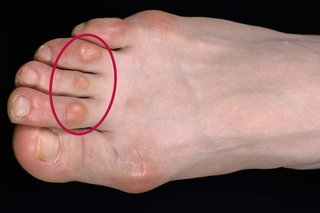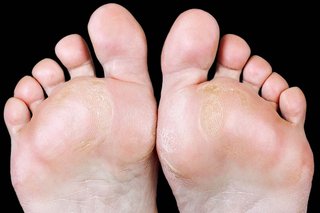How to Get Rid of a Corn on Pinky Toe
Corns and calluses are hard or thick areas of skin that can be painful. They're not often serious. There are things you can try to ease them yourself.
Check if you have a corn or callus
You mostly get corns and calluses on your feet, toes and hands.


Corns and calluses can also be tender or painful.
What you can do about corns and calluses
Important
If you have diabetes, heart disease or problems with your circulation, do not try to treat corns and calluses yourself.
These conditions can make foot problems more serious. See a GP or foot specialist.
Corns and calluses are not often serious and there are things you can try to:
- get rid of them yourself
- stop them coming back
Do
-
wear thick, cushioned socks
-
wear wide, comfortable shoes with a low heel and soft sole that do not rub
-
use soft insoles or heel pads in your shoes
-
soak corns and calluses in warm water to soften them
-
regularly use a pumice stone or foot file to remove hard skin
-
moisturise to help keep skin soft
Don't
-
do not try to cut off corns or calluses yourself
-
do not walk long distances or stand for long periods
-
do not wear high heels or tight pointy shoes
-
do not go barefoot
You can ask a pharmacist about:
- heel pads and insoles
- over-the-counter products to treat corns and calluses
- different kinds of pain relief
Find a pharmacy
Non-urgent advice: See a GP if you think you have a corn or callus and:
- you have diabetes
- you have heart disease or problems with your circulation
- it bleeds, or has any pus or discharge
- it has not improved after treating it at home for 3 weeks
- the pain is severe or stopping you doing your normal activities
What we mean by severe pain
- Severe pain:
-
- always there and so bad it's hard to think or talk
- you cannot sleep
- it's very hard to move, get out of bed, go to the bathroom, wash or dress
- Moderate pain:
-
- always there
- makes it hard to concentrate or sleep
- you can manage to get up, wash or dress
- Mild pain:
-
- comes and goes
- is annoying but does not stop you doing things like going to work
Information:
Coronavirus (COVID-19) update: how to contact a GP
It's still important to get help from a GP if you need it. To contact your GP surgery:
- visit their website
- use the NHS App
- call them
Find out about using the NHS during COVID-19
Treatment for corns and calluses
A GP can:
- look at your foot to see if it's a corn or callus
- give you antibiotics if a corn or callus is infected
- refer you to a foot specialist if they think you need further treatment
Treatment from a foot specialist
A foot specialist, such as a podiatrist, may be able to offer treatments such as:
- cutting away the corn or callus
- patches to help soften the hard skin so it can be removed
- specially made soft pads or insoles to take pressure off the painful area of your foot
Referral to a podiatrist on the NHS may not be available to everyone and waiting times can be long. You can pay to see a podiatrist privately.
Find a podiatrist
Common causes of corns or calluses
Corns and calluses are caused by pressure or rubbing of the skin on the hands or feet.
For example, from:
- wearing high heels, uncomfortable shoes or shoes that are the wrong size
- not wearing socks with shoes
- lifting heavy weights
- playing a musical instrument
Page last reviewed: 19 November 2018
Next review due: 19 November 2021
How to Get Rid of a Corn on Pinky Toe
Source: https://www.nhs.uk/conditions/corns-and-calluses/